Silkscreens, Contemporary Art, and a kid named Ferris

Preface
Before my full time devotion to the Ferrari Club, I designed contemporary lighting and manufactured hotel guest room lighting for 4 and 5 star hotels. One of my largest clients was Hyatt Hotels based in Chicago. During the 1990’s my sales representative in the area was Rob Rose and I would travel to Chicago a couple times a year and visit our clients with Rob.
When I first mentioned to Rob that I was a Ferrari fanatic, he shared a truly amazing personal story about his Ferrari experience.
Rob’s father, Ben Rose was a successful businessman in the textile industry and had a custom home built in the Chicago suburb of Highland Park in 1953. Ben was an avid car collector and had a glass pavilion added to the property in 1974 to house a portion of his collection and memorabilia.
In 1986 John Hughes was preparing to film his movie Ferris Bueller’s Day Off. Studio executive Ned Tanen, who was a Ferrari collector, suggested Ben Rose’s pavilion would be an ideal setting for the film’s most iconic scene.
The scene filmed at Rob’s house is considered one of the most famous Ferrari scenes in motion picture history, where the 1971 250 California Spyder slammed in reverse thru the glass wall and careened to the ravine below.
I recently introduced Rob to our Sempre Magazine profile author Jim Hunter and here is Jim’s interview.
-Jim Bindman
President, Ferrari Club of America Southwest Region
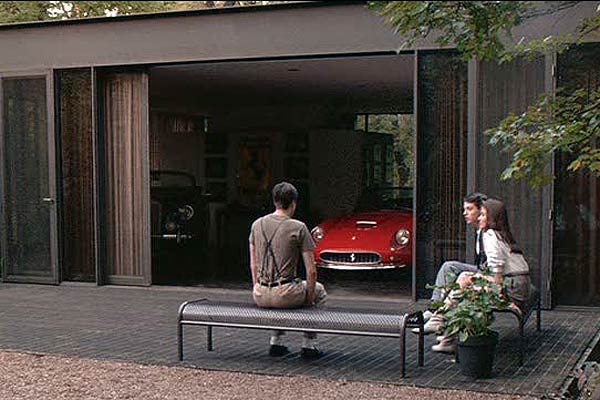
Jim Hunter’s interview with Rob Rose
“In 1953, my parents built a mid-century modern home in Highland Park. My Dad actually held a competition between three well-known architects in the Chicago area to design it, and he picked one submitted by James Speyer.
“The property was four acres, all forested with nothing around it, but we only owned an acre. The rest was owned by an old, recluse, school teacher who lived in a little log cabin in the middle of the forest. As kids, we used to make up all kinds of stories about her, ‘The Witch,’ etc.
“The concept of James’ design is that there are no straight lines in nature, so to place straight lines amongst nature is to create juxtaposition that is visually exciting and creates conversations. So this wonderful box sits on stilts, on a sloping grade that slowly drops down 35 feet into a ravine. The house is of course perfectly level, whereas the ground underneath it is not.
“There was nothing like it when we moved into the neighborhood. We were the weirdos. Everybody else had a regular frame, colonial type of house, and they looked at ours as some sort of spacecraft. There was a lot of interest, but there was also a lot of derision. Highland Park was pretty conservative at the time.
“With everything that my Dad was interested in, it was contemporary. He taught me to always look at the contemporary, to steep myself in what was happening at the time. His background was art. He went to the Art Institute, where he met my mother as a painter and a serigrapher.
“Serigraphy is silk-screen printing. His entire career evolved from silk-screening. He originally worked with my Uncle Irv, silk screening street signs, ‘No Parking’ signs, etc. He learned how to cut stencil and that later led to his career as a print designer and then into woven textile.
“He also became interested in sports cars, a result of his randomly seeing a flatbed-trailer towing a Porsche 356, a car he’d never seen anything like before. He followed it to Imperial Motors in Wilmette, asked some questions about it, and bought it.
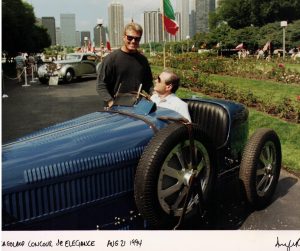
Rob with his Dad Ben and their Bugatti at the Chicagoland Concours, August 1994
“My Dad liked art, but his financial advisors found art a risky investment because it was subjective and sometimes took forever to attain any value whatsoever. ‘What else do you like,’ they asked. ‘I like cars,’ he replied. Perfect. They said invest in automobiles. Have a collection, and give it a meaning, a theme of some kind.
“I went off to school in California, and when I came back a year later, he had built this pavilion that cantilevered out over the ravine.
These ravines run forever around the North Shore. They’re what the North Shore was actually built on. He was the only one of all the residents that live along this ravine to build a structure that hangs out over the edge. The pavillion was designed to honor the lines of the main house, so it was also box-shaped, a true box, completely glass, with 14-foot glass windows all around it.
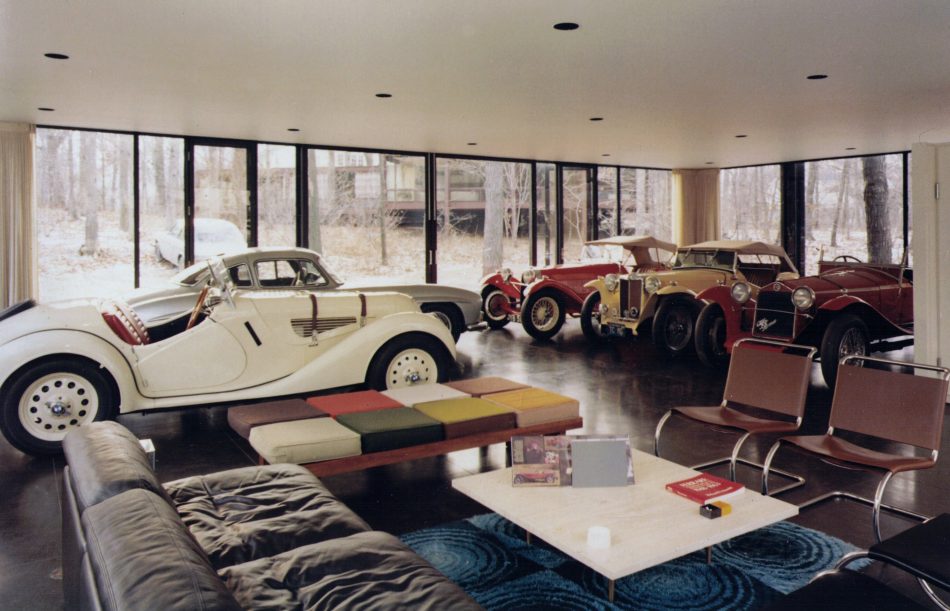
“Dad built it to house his car collection, which had reached about 12 different cars at that time. It is an apartment, too. It’s got a kitchen, a bath, a sleeping area, and all that kinds of stuff. I lived in it for a month, but would often wake up with screaming headaches from the car fumes.
“I was so lucky to have him as a father. They say you can’t pick your parents, but I couldn’t have done better. My Dad said so many wonderful, important things to me as we were driving away from his mother’s funeral. ‘You’ve got to forgive your folks before they go, or you’ll never forgive yourself,’ he offered. I’d been blaming my folks for everything until that point.
“In school, I was a poster child for psychedelia. I have a reputation, along with some fellow rock and roller band mates, for having created some iconic drug-related T-shirts in the ’60s. I was living on Mission Beach in San Diego with my friend Arnie Goodman. We had a band. I learned silk-screening from my dad, and we silkscreened T-shirts. “No one was doing much with t-shirts back then, but we printed on the kitchen floor and made about six of each design. One of those designs showed the earth exploding, where the reveal of the explosion created a peace symbol. On top and bottom it said, ‘Come Together.’

“We put the shirts on consignment at this head shop down the street. They didn’t sell, so after a month or so, we picked them up and gave them away to our friends. I moved back to Chicago and forgot about all of that crap.
“In 1989, John Lennon had just been assassinated, and I’m reading a magazine article about him in a drug store in Rogers Park. There was a photograph of him and Yoko in some backyard somewhere, and he’s wearing our shirt, one of only six made, and my jaw dropped. I couldn’t believe I.
“I thought how did he get this shirt? How did this happen? I called Arnie, who was now in Oregon, and he had no idea except that after I left, our band was signed by Frank Zappa in Hollywood. Zappa and Lennon had some experiences together. Maybe Zappa gave him the shirt? It’s the only thing we could possibly think of.
“Later on, I got a call from Arnie, “Google John Lennon, Come Together.” I Google it and there’s literally hundreds of websites selling the shirt. I’m thinking this is ridiculous. Literally hundreds of shirts, all of them slightly different, like they had knocked each other off. The last T-shirt looked like a kindergartner did it with his left hand when he was right-handed. It was embarrassing.
“We thought, ‘Wow, look at all these companies. We’ve got a lawsuit here; we’ll make a fortune.” However we then realized we didn’t know where they were, we’d have to show loss, and we’d have to show copyright. We didn’t have any of this. So, we forgot about it. We gave up on it.
“But Arnie came to visit his folks in Highland Park, and we’re in the basement, and he finds the screens. Forty years later, he finds the screens that printed Lennon’s shirt, so we had proof.
“We went to the biggest of the companies that were knocking us off, and sold them the design, the screens, and the rights to the shirt. It wasn’t a ton of money, but it was a decent amount, and they turned around and sued all the other competitors out of business. They have also hooked up with Yoko, who wants to use the T-shirt as part of her charity. There has been talk of flying Arnie and I to London to participate in the charity.
“Anyway, it’s a side story related to Dad, because he taught me how to cut silkscreens. He was a tremendous influence on me.”
But let’s get to FERRIS BUELLER’S DAY OFF, and the famous shot of the Ferrari flying out the window . . .
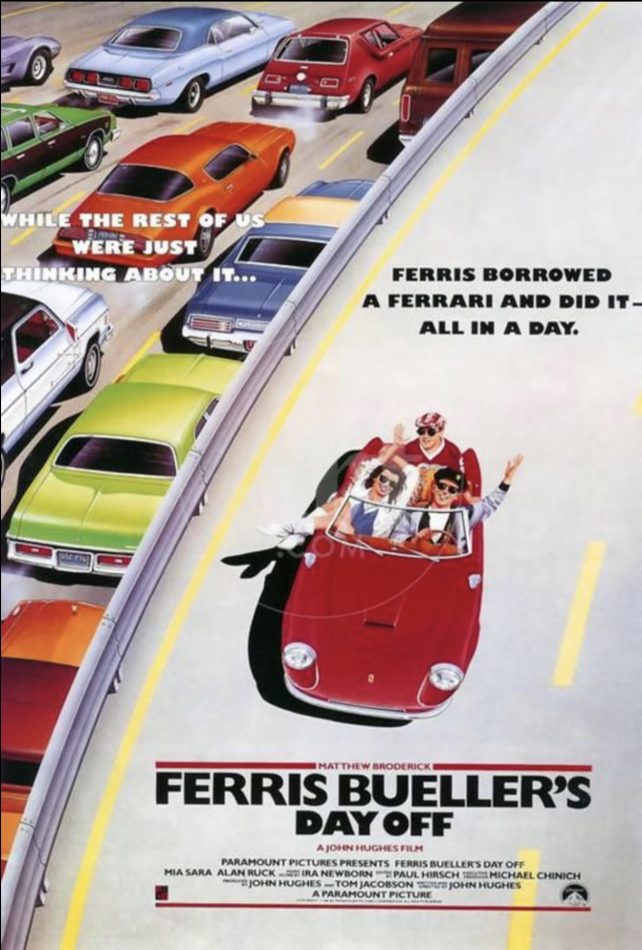
“Oh yeah, yeah. The movie was shot in ’85.
“It wasn’t unusual because there’d been other movies made in just a few blocks of each other. RISKY BUSINESS, SIXTEEN CANDLES, HOME ALONE, ORDINARY PEOPLE were made there. People were used to this around Highland Park.
“John Hughes lived in Northbrook, which is a little bit west of Highland Park. He was driving around the area, drove over the bridge, and saw our house and stopped. ‘I want to put that in a movie.’ He didn’t know what movie, but when Ferris came around, he drove back, pulled into my folks’ house, and knocked on the door. He described who he was, and said he wanted to make a movie there. They didn’t know who John Hughes was, but they were familiar with all the other shoots that had been around there, and they were honored.
“They thought it was exciting, but they didn’t realize what an imposition it was going to be. There must’ve been ten giant vans that they brought in with all these tech people. One of them was just for the chef and the dining area for the top crew and cast.
Hughes said he was going to be there for six days, and it was six weeks. My folks were unfortunately gone when the car went through the glass. They’d had scheduled a jazz cruise with a group and couldn’t get out of it.
“One of the interesting things about the shoot was that the storyline takes place in the spring where they’re about to graduate from high school. The shot was done during the fall, and the leaves were changing. Hughes panicked and had his crew spray paint all of the leaves green, at least all the leaves that you see.
“Having paid your three bucks, you’re sitting in the seat watching the movie, and you want to be fooled. It’s the suspension of disbelief. All it takes are a few little plastic posies stuck in the ground strategically, the camera sees it for a nanosecond, and it sells the whole thing.
“The ‘witch’ had also passed away, and her family had parceled the property into three McMansions that loom in on the pavillion. What can you do? They lock the camera down so that it only can turn so far. Everything that’s out of the range of the camera doesn’t exist.

“Watching a movie being made is the most boring thing you’ll ever do. It’s like 12 guys standing around, looking into a hole, with one guy in the hole. Shooting a movie has everything to do with the rental of things, props and stuff like that. They also schedule their time down to a moment.
“One thing that was interesting is they brought, at no small expense, a giant 14-foot square piece of what’s called sugar glass. It’s the stuff that they make the bottles out of for bar fights in movies. It’s literally made out of a sugar compound that mimics glass when it breaks. John Hughes looked at and said, “It looks fake.” It didn’t look like the other glass in building, so the architect/consultant gave his blessing to drive the fake Ferrari through the real window.
They had cautioned that they would do the shot on a moment’s notice, but because it all had to do with the weather and rentals, they didn’t know when they were going to shoot.
“I got a call at work that they would be shooting. I raced 25 miles back to my folks’ house to watch. I was ushered out to the bridge, which affords an incredible view of both the house and the pavilion hanging over the edge. It’s very dramatic. There was a camera right there next to me, and I wanna say six more cameras, set up in the ravine below and directly across from the pavilion itself.
“Almost the minute I got there, the car burst through the glass. Now, I didn’t hear anybody yell ‘three, two, one,’ or anything like that, it just went through the glass, and from the bridge, it was very dramatic.
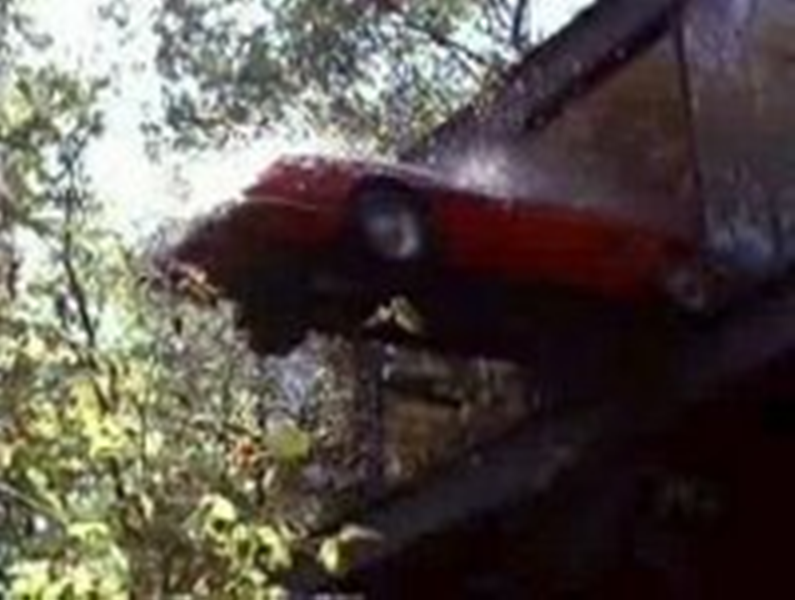
My heart clogged in my throat. I didn’t think I would have an emotional reaction, but if felt like a violation of the house, our home.
“The fiberglass shell hit the ground, about 25, 30 feet below, and since it was fiberglass, landed fine (laughs). They had to send a team down there to beat at it, light some smoke bombs and stuff to make it look like it had really been mashed up. It was fun to watch, but I was sorry that my folks were away.
“Hughes had been worried that they were losing their patience, so he plied them with all kinds of fancy dinners. The producers started inviting them to dinner every night. They were eating lobster, and the chef was fantastic.
“We went to the premier of the movie here in Chicago. My parents were delighted. They were happy that they’d made the decision.
My mother got a kick out of it. She says that she could tell when the show was on TV because the traffic the bridge would increase with people staring.
“And, it’s added to my story. I didn’t get a sense that it was going to be a cult favorite. The movie didn’t have any momentum for a good five to 10 years after it came out. But to be honest, I’m a little Buellered out (laughs).
“The producers gave my Dad this wonderful Ferrari toolbox on wheels and castors. It’s about four-feet high, has about eight drawers, with the Scuderia shield on the outside. It’s Ferrari red, gorgeous.”
Ironically, Rob’s Dad owned a real 250 Cal Spyder at one time.
“Oh yeah, he worked his way up to a Ferrari, and he even had a 250 California Spyder, but traded it away. He regretted it years later.”

Photos courtesy Rob Rose
Originally published in Vol. 29, No. 4 of SEMPRE FERRARI, the magazine of the Ferrari Club of America Southwest Region
Tags: 250250 Cal SpyderCalifornia SpyderCome TogetherFerrariFerris BuellerJames SpeyerJohn HughesJohn LennonseriagraphyYoko Ono